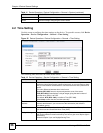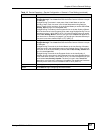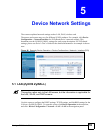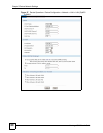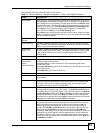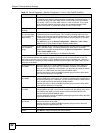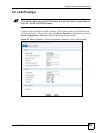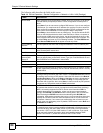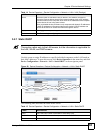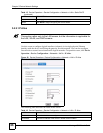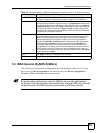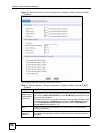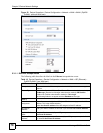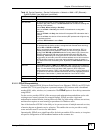
Chapter 5 Device Network Settings
Vantage CNM User’s Guide
64
The following table describes the fields in this screen.
Table 14 Device Operation > Device Configuration > Network > LAN > LAN (Prestige)
LABEL DESCRIPTION
DHCP Mode DHCP (Dynamic Host Configuration Protocol, RFC 2131 and RFC 2132) allows
individual clients (computers) to obtain TCP/IP configuration at startup from a
server.
Select None if you do not want to configure DNS servers. If you do not configure
a DNS server, you must know the IP address of a machine in order to access it.
When configured as a Server, the device provides TCP/IP configuration for the
clients. When set as a Server, fill in the rest of the DHCP setup fields.
Select Relay to have the device act as a DNS proxy. The device tells the DHCP
clients on the LAN that the device itself is the DNS server. When a computer on
the LAN sends a DNS query to the device, the device forwards the query to the
device’s system DNS server and relays the response back to the computer. You
can select Relay and enter an IP Pool Starting Address. The First DNS Server
IP and Second DNS Server IP will appear as read only fields.
IP Pool Starting
Address
This field specifies the first of the contiguous addresses in the IP address pool.
DHCP Server IP If Relay is selected in the DHCP field above, then type the IP address of the
actual, remote DHCP server here.
Pool Size This field specifies the size, or count of the IP address pool.
First DNS Server IP
Second DNS
Server IP
The device passes a DNS (Domain Name System) server IP address (in the
order you specify here) to the DHCP clients. Type your First DNS Server IP and
Second DNS Server IP addresses in these fields.
TCP/IP
IP Address Type the IP address of the device in dotted decimal notation.
IP Subnet Mask The subnet mask specifies the network number portion of an IP address. Unless
you are implementing subnetting, use the “natural” subnet mask, which is usually
255.255.255.0.
RIP Direction RIP (Routing Information Protocol, RFC1058 and RFC 1389) allows a router to
exchange routing information with other routers. The RIP Direction field controls
the sending and receiving of RIP packets. Select the RIP direction from Both/In
Only/Out Only/None. When set to Both or Out Only, the device broadcasts its
routing table periodically. When set to Both or In Only, it incorporates the RIP
information that it receives; when set to None, it does not send any RIP packets
and ignores any RIP packets received. Both is the default.
RIP Version The RIP Version field controls the format and the broadcasting method of the
RIP packets that the device sends (it recognizes both formats when receiving).
RIP-1 is universally supported but RIP-2 carries more information. RIP-1 is
probably adequate for most networks, unless you have an unusual network
topology. Both RIP-2B and RIP-2M sends the routing data in RIP-2 format; the
difference being that RIP-2B uses subnet broadcasting while RIP-2M uses
multicasting. Multicasting can reduce the load on non-router machines since they
generally do not listen to the RIP multicast address and so will not receive the
RIP packets. However, if one router uses multicasting, then all routers on your
network must use multicasting, also. By default, RIP direction is set to Both and
the Version set to RIP-1.
Multicast Select IGMP V-1 or IGMP V-2 or None. IGMP (Internet Group Multicast Protocol)
is a network-layer protocol used to establish membership in a Multicast group - it
is not used to carry user data. IGMP version 2 (RFC 2236) is an improvement
over version 1 (RFC 1112) but IGMP version 1 is still in wide use. If you would
like to read more detailed information about interpretability between IGMP
version 2 and version 1, please see sections 4 and 5 of RFC 2236.
Any IP Setup



